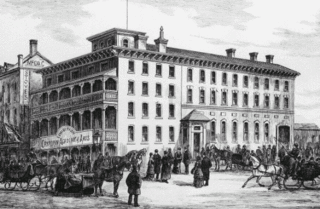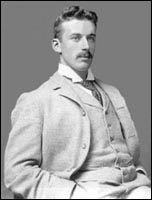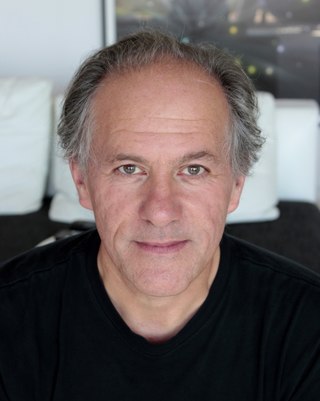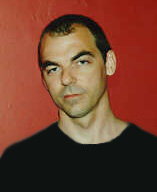Luc Courchesne | |
|---|---|
 | |
| Born | May 20, 1952 |
| Occupation(s) | artist, professor |
| Notable work | Portrait One, Family Portrait |
| Website | courchel |
Luc Courchesne RCA D.F.A. (1952) is a Canadian artist and academic known for his work in interactive art. [1]
Luc Courchesne | |
|---|---|
 | |
| Born | May 20, 1952 |
| Occupation(s) | artist, professor |
| Notable work | Portrait One, Family Portrait |
| Website | courchel |
Luc Courchesne RCA D.F.A. (1952) is a Canadian artist and academic known for his work in interactive art. [1]
Luc Courchesne was born May 20, 1952, in Saint-Léonard-d'Aston, Quebec. [2] He received a bachelor's degree in design from the Nova Scotia College of Art and Design in 1974. In the 1980s, he received a Master of Science degree in visual studies from the Massachusetts Institute of Technology. [3] [4] Courchesne was a member of the MIT Media Lab at its inception in 1985. [5]
Courchesne was a professor of industrial design at the Université de Montréal. [6] [7]
Courchesne is known for his interactive video installations and environments. He began working in interactive video in 1984 when he co-authored Elastic Movies, [8] and since has produced many installation works and image series. In his early works such as Family Portrait and Portrait One (1989), [5] [9] the viewer interacts with the a human image programmed to engage in a lifelike conversation with the viewer. [10] [11] His later work Landscape One (1997) [5] [12] surrounds the viewer with a 360 degree immersive and interactive video projection of a park. [13] [14] [15]
On September 11, 2001, while he was on assignment in New York City for a "Québec–New York" cultural event, Courchesne happened to be videotaping the smoldering North Tower of the World Trade Center as the second plane hit the South Tower. The 23-minute video of his experience on that fateful day was available at CBC/Radio-Canada archives .
In 1994, he exhibited his work in a solo show at the Museum of Modern Art in New York titled Project 47: Luc Courchesne. [16] and has had numerous later solo and group shows, both nationally and internationally. In 2022, Luc Courchesne - Observateur du monde, an exhibition, was shown at the Carrefour des Arts, Université de Montréal. [17] He is represented by gallery Pierre-François Ouellette art contemporain in Montreal.
He has been awarded several artist-in-residence positions internationally. [18] Since 1996, he has been a member of the Society for Arts and Technology in Montreal. He was Chairman of the Board of Directors from 1996 to 2005, then Vice-Chairman from 2005 to 2008.
Courchesne's work is included in the permanent collection of the National Gallery of Canada, [2] [19] Musée national des beaux-arts du Québec [20] and elsewhere as well as in many institutions internationally such as the Zentrum für Kunst und Medientechnologie (ZKM) in Karlsruhe. [21]

The Royal Canadian Academy of Arts (RCA) is a Canadian arts-related organization that was founded in 1880.

Norman White Canadian New Media artist considered to be a pioneer in the use of electronic technology and robotics in art.

The Musée national des beaux-arts du Québec, abbreviated as MNBAQ, is an art museum in Quebec City, Quebec, Canada. The museum is located in National Battlefields Park and is a complex of four buildings. Three of them were purpose-built for the museum and one was originally a provincial prison.
Gilles Gobeil is an electroacoustic music composer from Sorel-Tracy, Quebec, Canada, and currently living in Montreal, Quebec, Canada. Gobeil received his musical education at the Université de Montréal. Gobeil is professor for music theory at the Cégep de Drummondville and was guest professor for electro-acoustics at the Université de Montréal and at the Conservatoire de Montréal.

William Brymner, was a Canadian figure and landscape painter and educator. In addition to playing a key role in the development of Impressionism in Canada, Brymner taught numerous artists who became leading figures in Canadian modern art.

George Legrady is a multidisciplinary digital media artist and university professor in photography and computational media arts.
Sylvie Bélanger was a Canadian interdisciplinary artist using sound, video, photography and installation. She lived and worked in Toronto as an Associate Professor of Visual Studies at SUNY Buffalo until her retirement in 2017. Where after, she moved to Montréal.
Christian Langlois is a Canadian film director based in Montreal, Quebec. He has directed several short films, video content, series, commercials, music videos and media installation. He studied at Université du Québec à Montréal in communications programs photography, cinema, art video and new digital media. He published several articles about the role of digital technologies and video in the development of visual and performing arts.

Bill Vorn is a Canadian artist, musician and professor known for his robotic artworks. Vorn was also a member of the band Rational Youth from 1981 to 1983.
Lani Maestro is a Filipino-Canadian artist who divides her time between France and Canada. She works in installation, sound, video, bookworks and writing. From 1990 to 1994 Maestro was co-founder/co-publisher and designer of HARBOUR Magazine of Art and Everyday Life, a journal of artworks and writings by artists, writers and theorists based in Montreal.
Trevor Gould is a Canadian contemporary artist known for his sculptural and conceptual artworks.

Andrew Dutkewych is a Canadian contemporary artist known for his sculptural works.

For the American jurist, see Nancy Paterson.
Adam Basanta is a Montreal-based artist and experimental composer whose practice investigates manifestations of technology as a meeting point of concurrent and overlapping systems. He uses various media and creates participatory and multi-sensory performances.

Steve Heimbecker is a Canadian sound artist, pioneer of sound art in Canada. His works are part of the collection of the Musée national des beaux-arts du Québec and the Alberta Foundation for the Arts. His work has been exhibited in Canada, the United States, Peru and Europe.
Francine Savard is a Canadian artist whose paintings and installations are grounded in the Plasticien tradition. Her practice explores relationships between language and visual art. Besides painting, Savard has a career as a graphic designer.
Nicolas Grenier is a Canadian artist and painter. His paintings, sound recordings, and installations focus heavily on how certain principles in society converge and interact. His goal is to reveal how the individual interacts with the collective body and how the architecture we find ourselves in defines our subconscious and our interactions with each other. The foundation of his work is painting but in recent years he has expanded his practice to encompass a variety of mediums and think tank initiatives. His interest lies in the distorted connections of political, economic, cultural and social principles and how moneyless economies, radical inclusivity, giving up individualism, and other ideas could evoke a paradigm shift in values and beliefs.
Richard Lacroix is a Canadian engraver, painter and sculptor who increased recognition for Canadian printmaking. He was the founder of Atelier Libre (1964), the first printshop in Canada which made printmaking facilities available to contemporary artists, as well as the Guilde Graphique (1966).
Pierre Ayot was a multidisciplinary artist, university professor and the founder of Atelier Libre 848 (1966), an art centre devoted to printmaking that provides its members with training, expertise and facilities. He also was a founding member of the group Média, gravures et multiples (1969).
Roland Poulin is a Canadian contemporary sculptor whose work is characterized by its horizontality and weightiness. He has lived in Sainte-Angèle-de-Monnoir, Quebec, since 1986.